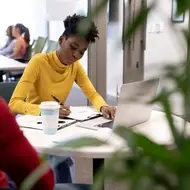How to Make the Most of Your Grad School Campus Visit

Do you remember the feeling of visiting your undergraduate campus for the first time? Learning about the resources and programs available to you and seeing current students walk around campus was probably a major factor in helping you decide where to go for college. So why wouldn't you use that same strategy when narrowing down your list of potential graduate programs?
The grad school campus visit can be tough to coordinate if you don't live near the schools that interest you, but there are few things more informative than in-person experiences. If you are able to schedule a campus tour, it's important to make the most of your few hours or days on campus. After all, it may just become the place you spend 2+ years!
Planning for a grad school campus visit
Take a look at the admissions calendar to see if you’re able to visit when there are interesting events, such as an alumni panel or open house weekend for prospective graduate students. Visiting campus on one of these days will give you the chance to meet other prospective graduate students who are interested in the program. Also, you'll be able to plan your trip in advance to help with logistics like transportation (if you’ll need to fly or take the train), lodging (if you’re planning to stay more than one day) and scheduling meetings.
Take full advantage of your campus visit by meeting with as many representatives as possible. You might pair your visit with a formal admissions interview, but if not, be sure to still make an appointment with the admissions office. It’s a good chance to put faces with the names you’ve likely been emailing as you’ve researched the program and submitted your application. More than that, it's a great way to make a good impression on the very people who will read your application!
Try to reach out to the admissions office before your visit to ask about the possibility of sitting in classes, meeting with current graduate students, or joining other student events that can give you a good sense of the program. Schools generally love for prospective students to sit in on classes, but each one will have different policies about how to it set up. Sometimes you can sign up for a class visit right on the school’s website, but other times the admissions office will refer you to the registrar or individual professor.
During your campus visit
Take it all in. Pay attention to everything from the way students interact and what the area is like around campus to how the classes feel—you'll want to know whether the school feels like a good fit for you. Make sure to dress professionally and wear comfortable shoes, as you’ll likely be doing a lot of walking around campus.
Here a few additional tips for making the most of your campus visit:
Go to the Admissions Office
Even if you’re not interviewing formally, it’s important to be prepared for your visit with the admissions team. You’ll make a much stronger first impression if you have done your homework about the university and program you're interested in.
Bring questions that you haven’t been able to answer from researching their website, and be sure to express your excitement about the program. You’ll also likely set up other parts of your campus visit, like participating in an official tour or panel discussion, so be sure to express gratitude and be thoughtful about your requests.
Interview with the admissions team
Graduate admissions interviews are formal conversations with a representative from the university that allow you to share your passion for the field, accomplishments, and enthusiasm for a specific program. Not all schools require an interview, but if they do, make sure to prepare for it as though it were a job interview.
Meet with the Financial Aid office
Depending on your school or department, you may want to schedule a separate visit with the financial aid office. Even if you aren’t sure whether you will attend the grad school you’re visiting, it’s a good idea to think seriously about how you’ll finance your degree and understand the options and opportunities available to you.
At the financial aid office, you should learn about scholarships, assistantships, and grants offered through the school, as well as external funding sources (such as student loans and special funding specific to your field of study). For funding available through the school, find out what the eligibility requirements are, whether you need to supplement your grad school application with additional documentation or materials, and what the deadlines are to be considered for funding. (Keep in mind that your chances for securing funding are better if you submit your application early!)
A visit to the financial aid office can prove very valuable, both in terms of accessing funding information as well as developing a rapport with a financial aid officer. You’ll feel more comfortable asking questions once you’re back home if you have the name and contact information of a real person in the financial aid office.
Visiting your program's specific department
If the admissions and financial aid office are general administrative offices for the university, you should also seek out the offices of your specific department. It should be possible to schedule chats with the administrative staff and faculty and ask to be put in touch with current students. It’s also a good chance to pick up copies of any journals or other publications the department has created, as these can offer valuable insights into the program’s character.
For conversations with faculty, be prepared and respectful. Do some research ahead of time about the professor’s area of research and recent publications, and don't forget to share information about how your own professional and academic interests relate to the program.
If you get the opportunity to meet with current grad students, think ahead about some questions you want to ask them. Here are a few examples:
- What is your favorite part of this program?
- What is your least favorite part of this program?
- What has your experience been working with professors in this program?
- How easy has it been for you to make connections with working professionals in your field?
- What are your plans after you graduate?
- What are your favorite things to do on and off campus?
Sit in on a class
See if you can find a list of available courses (you can usually find this in the program handbook) and ask the admissions office if you can sit in on a class. Also, consider sitting in on the classes of a particular professor you are interested in working with.
Before attending class, reach out to the professor about how you can prepare. They might want you to read some course materials ahead of time and expect you to participate in class discussions. Also, see if you’re able to take a look at the course syllabus to get a better sense of the content, required reading, and workload.
During class, pay attention to the interaction between instructor and students. Do students seem engaged and challenged? What is the professor’s teaching style? Would you be excited to take a course like this as a part of your graduate study? How else does the class stack up to your expectations and goals?
As you consider these questions, remember that generalizing from one class is rarely advisable or accurate. Your class visit is a great chance to experience one part of the program, but it’s not going to give you a complete picture of what the program in its entirety.
Take a campus tour
The admissions office can let you know about scheduling an official campus tour during your visit. The advantage of joining a formal tour is that your tour guide will have a sense of what prospective students are interested in seeing, and can often provide background on the university’s history and fun facts about campus. Tour guides are also used to getting questions, so they are prepared to offer a range of information.
If a formal tour isn’t taking place the day of your visit, consider planning ahead to meet up with a current student who can show you around. Whether or not you take a formal tour, you can (and should) take a campus map and have a look around on your own. Though grad school isn’t known for giving students copious free time to enjoy their surroundings, you should devote part of your campus visit to off-campus exploration.
After your grad school campus visit
Immediately after your visit, send thank you notes to the professors, students, and staff members you met. You can have the thank you notes stamped, addressed, and ready to go (save for writing the note itself) when you arrive on campus; otherwise, jot down the email addresses or phone numbers of people who gave you their time.
Following up with these contacts helps you keep channels of communication open in the event that you have further questions about your target program or destination.
On your trip home, take some time to reflect on your experience. Make a point of talking to a friend or writing about your experience to help process your thinking. Some questions that may be helpful to reflect on include:
- What did you learn?
- In what ways did this visit meet your expectations?
- In what ways were you disappointed?
- How interested are you in exploring this academic program further?
- What values, skills, and interests of yours fit—or don’t fit—with the degree, department, university, or student culture?
Safe travels as you explore your schools and get a taste of campus life!
***
Planning on returning to school? Check out our Grad School Resources. And if you’re interested in speaking with an admissions representative, RSVP for Idealist Grad School Fair this fall.
I oversee the content and resources we share at Idealist to help organizations, prospective grad students, and job seekers make an impact in their personal and professional lives. In my spare time, I love to read, cook, and explore NYC's parks.






